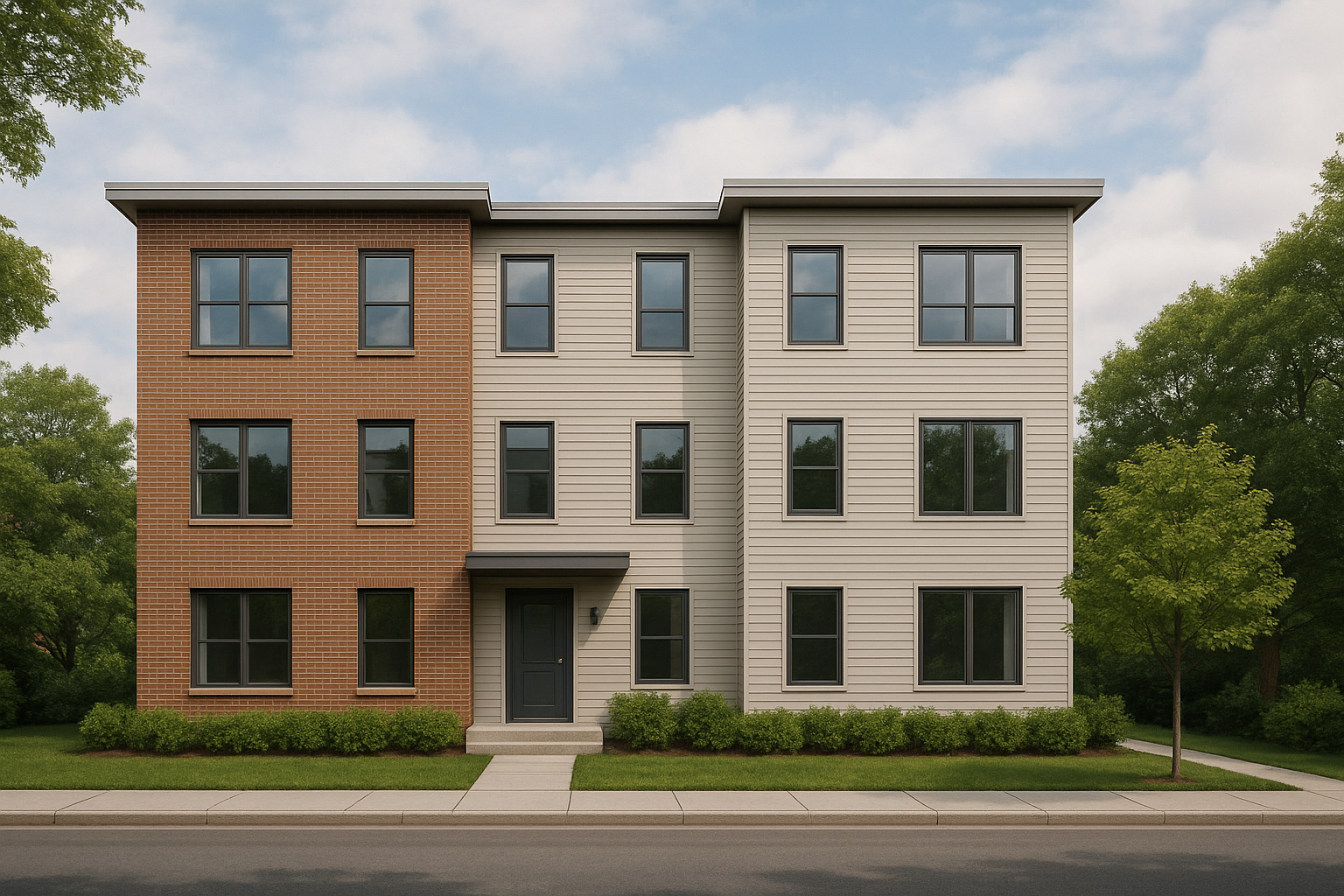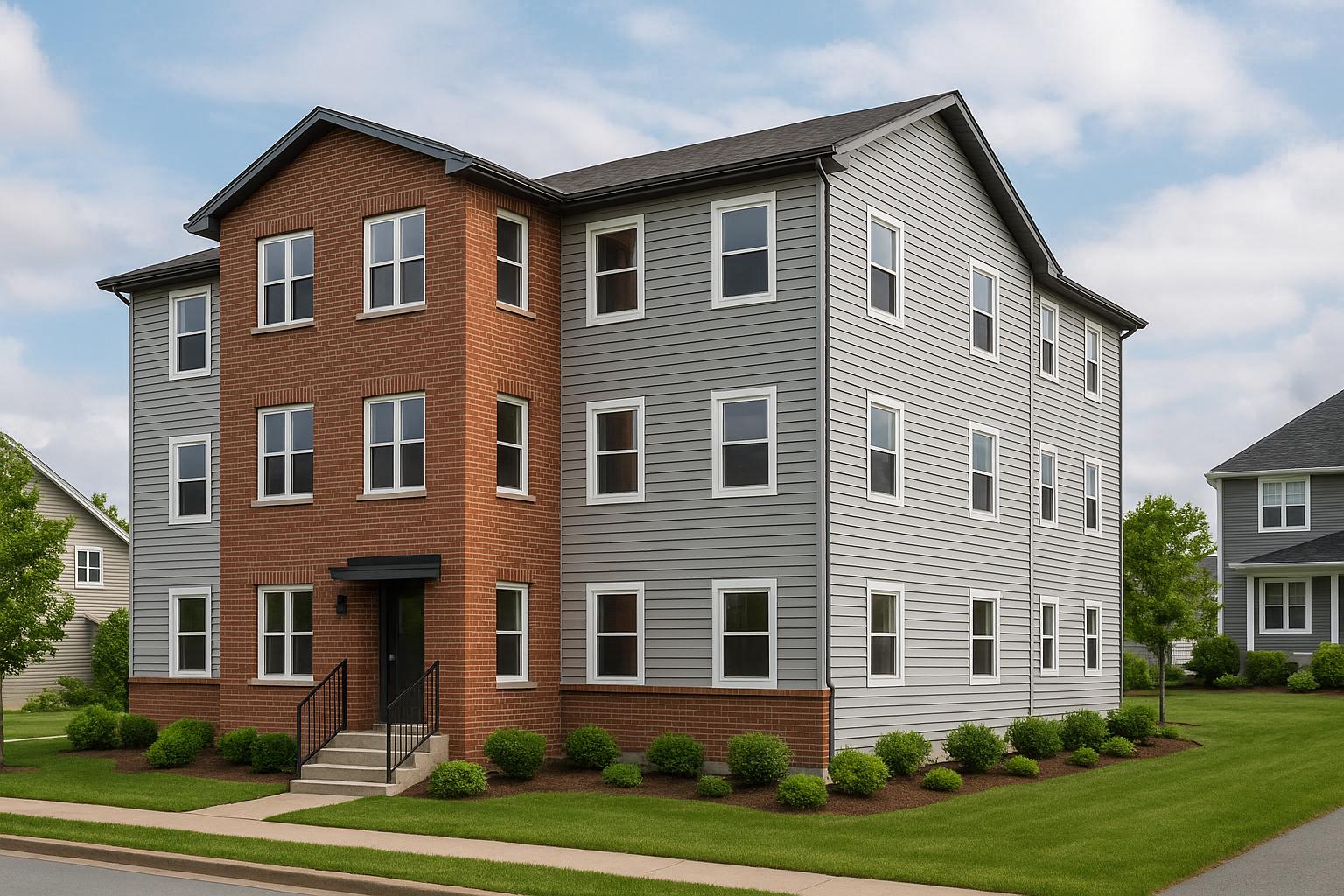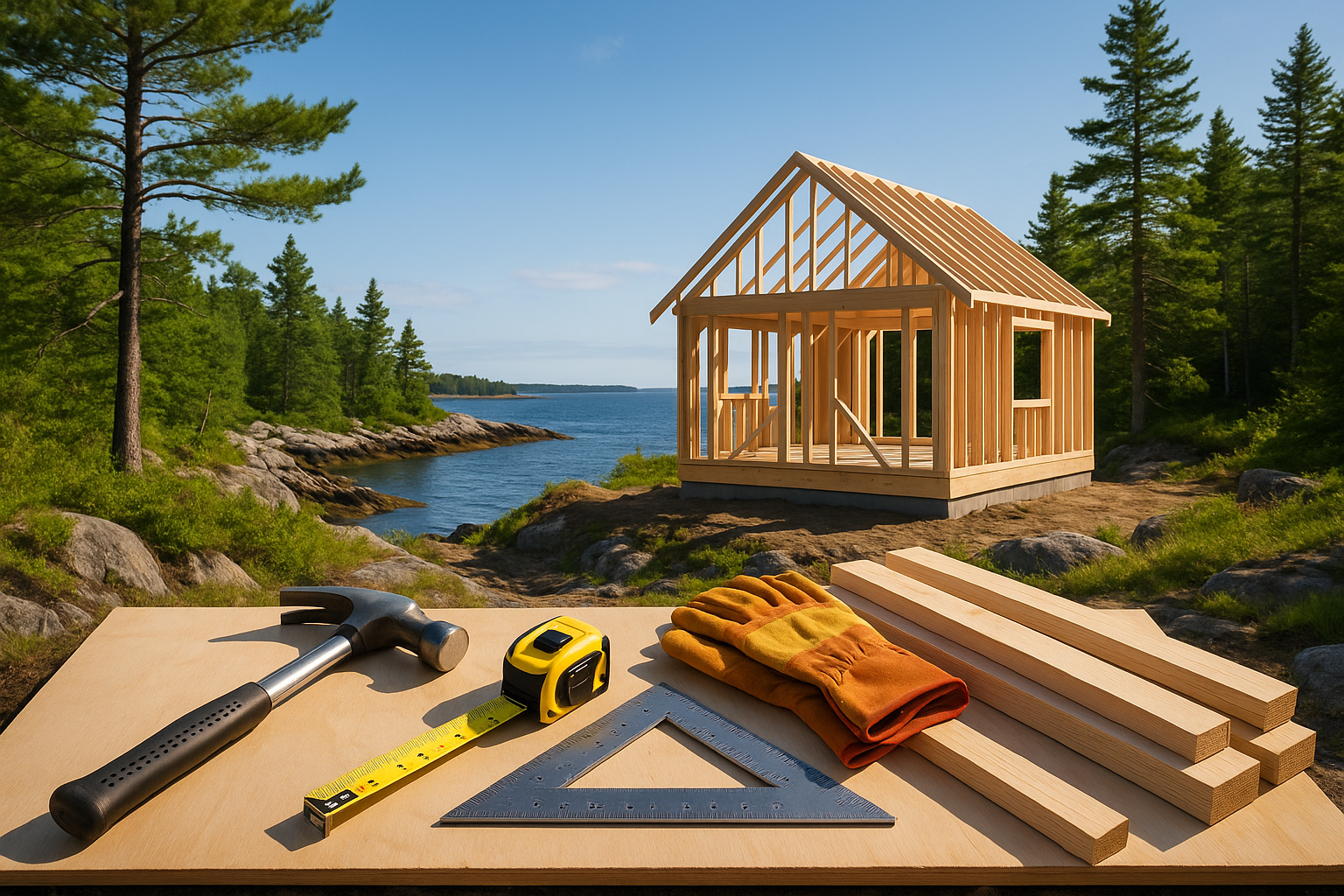- Lower Costs: Reduce energy use by up to 50%, cut operating costs by 30%, and enjoy higher rental rates.
- Design Essentials: Focus on passive building envelopes, AI-controlled HVAC systems, and water-saving tech.
- Green Materials: Use innovations like CarbonCure concrete and mass timber to cut emissions.
- Renewable Energy: Solar panels and ground-source heat pumps boost efficiency and property value.
- Funding Support: Access up to $21.9M in provincial incentives and special loan programs.
Nova Scotia’s bold climate goals and new building codes make this the perfect time to act. Start building smarter, greener, and more profitably today.
Design Elements for Net-Zero Buildings
Building Shell Design
Proper insulation and sealing of the building envelope can drastically lower energy needs. Heating and cooling alone account for about 70% of CO2 emissions in the building sector [2].
To improve energy efficiency, developers should focus on insulating all six sides of the building envelope. Modern materials like Elevate ISOGARD polyiso offer up to 40% better thermal performance compared to older options [2]. Techniques such as exterior rigid insulation, single plate double stud walls, or double plate wall systems can help achieve the high R-values needed for energy-efficient designs [3].
"A passive building envelope is the best way to protect your investment." – EkoBuilt [1]
Energy Systems
Once the building envelope is optimized, attention should turn to improving mechanical systems. HVAC systems, for instance, can consume up to 40% of a building's total energy [4]. Integrating smart technologies can significantly enhance performance. For example, GFT Spain's AI in HVAC systems reduced temperature violations by 80% and cut energy use from 54 MW to 46 MW [4]. These upgrades work hand-in-hand with smart control systems to boost efficiency.
Here’s a quick look at potential savings from key system upgrades:
| System Component | Potential Savings |
|---|---|
| AI-Controlled HVAC | 15% energy reduction |
| Natural Gas Systems | 15% cost reduction |
| Optimized Insulation | Up to 20% total cost savings |
For HRM multi-unit buildings, the ideal insulation thickness ranges from 1.8 to 3 inches, depending on the material used [6]. Smart building management systems (BMS) also provide detailed control of HVAC operations, ensuring both energy efficiency and occupant comfort [5].
Water-Saving Features
In addition to energy efficiency, water-saving technologies play a key role in net-zero buildings. Multi-unit buildings benefit from automated, tamper-resistant systems [7]. Products like the Toilet Scrooge™ use motion sensors to stop leaks, while behind-wall controllers and Smart Valve™ systems improve metering accuracy and cut water usage, potentially lowering bills by 15–25% [7]. GreyLink systems, which recycle washing machine water for toilet flushing, create a closed-loop system that significantly reduces the need for fresh water.
Net Zero Energy Ready in Nova Scotia
Materials and Building Methods
Choosing the right materials is a key step in reducing embodied carbon and moving toward net-zero construction.
Green Building Materials
Some companies are leading the way with innovative solutions. For example, CarbonCure (based in Nova Scotia) injects CO₂ into concrete, trapping it and cutting emissions. Similarly, mass timber, like the CLT panels used in an 8,500‑square‑foot branch in Texas, and bio-based options such as mycelium insulation, offer eco-friendly alternatives to traditional materials. These choices not only reduce emissions but also lower operational energy needs and improve financial returns. It’s worth noting that conventional building materials are responsible for around 11% of global emissions [8].
"Material selection is a social justice issue. Opting for nontoxic products not only creates healthy buildings, but it results in positive ripple effects for communities around the world."
– Gina Ciganik, CEO of the Healthy Building Network [8]
Factory‑Built Components
Factory-built components are another way to enhance sustainability. By ensuring precise material use, this method can save up to 20% in materials and cut energy consumption during construction by about 67% [9][10].
| Construction Aspect | Traditional | Modular |
|---|---|---|
| Waste Reduction | Baseline | Up to 90% less |
| Energy Efficiency | Standard | 15% better |
| Construction Waste | Full amount | 83.2% reduction |
Factory environments also allow for better quality control, especially for insulation and airtightness. This controlled setting ensures materials are applied consistently and that sealing techniques are properly executed, boosting overall building performance [9].
Construction Site Efficiency
Efficient practices on-site play a big role in achieving net-zero goals.
Good site management helps reduce waste and make the best use of resources. For example, hiring quantity surveyors and setting up recycling zones can shrink construction waste by as much as 75% [11].
"Material choices influence home quality, indoor air, and our carbon footprint." – Katie Rothenberg, vice president, ESG, AvalonBay [8]
Repurposing existing structures can also make a huge difference. Gensler’s project in Denver, which revamped a 230,000‑square‑foot building, cut embodied carbon emissions by 68% [8].
Planning ahead and working closely with suppliers is key. Using returnable containers, storing materials correctly, and leveraging Building Information Modeling (BIM) technology ensures better coordination and reduces waste [11][12].
sbb-itb-16b8a48
Power Generation Systems
Renewable energy systems play a key role in achieving net-zero goals for multi-unit buildings. Combining multiple renewable sources can increase efficiency and reduce costs.
Solar Panel Setup
The cost of solar installations has dropped significantly, now averaging between $0.80 and $1.80 per watt [14]. For example, a 100-kilowatt commercial solar system can produce around 136,000 kilowatt-hours of electricity each year [17].
Here’s a breakdown of typical solar setup costs:
| Component | Cost Percentage |
|---|---|
| Solar Panels | 40% |
| Labor | 25% |
| Mounting/Inverters | 35% |
Solar panels generally have a lifespan of 25–30 years. Adding battery storage to your solar setup can help manage energy more effectively and boost overall output.
Battery Systems
Battery storage can increase solar energy usage by 19% and cut peak electricity demand by 30% [15]. Community-based energy storage systems offer similar benefits but require only 65% of the capacity compared to individual setups [15]. Virtual Power Plants (VPPs) further streamline energy distribution while helping stabilize the grid [16]. These advancements also make it easier to adopt alternative heating and cooling methods.
Ground-Source Heat Systems
Ground-source heat pumps come with higher initial costs but deliver better long-term efficiency compared to air-source systems [18].
Real-world examples highlight the benefits of integrated systems. For instance, Westminster senior living community installed a 413 kW rooftop solar system that is expected to save $50,000 annually [17]. Similarly, Ben E. Keith Beverages' distribution centers anticipate a five-year return on investment from their solar installations [17].
Developers should prioritize site assessments, explore unconventional installation locations, use smart energy management tools, and stick to maintenance schedules [14]. Homes equipped with these systems can achieve energy efficiency levels 80% higher than standard new construction [13].
"Every part of a Net Zero Home works together in harmony to create the ultimate energy efficient living space." – Canadian Home Builders' Association [13]
Money-Saving Programs
Nova Scotia's commitment to achieving net-zero emissions by 2050 has opened up funding opportunities designed to lower long-term operating costs for multi-unit developers.
Government Support Programs
The province has introduced a $21.9 million investment package aimed at supporting sustainable development projects [19]. One key initiative is the Affordable Rental Construction (ARC) pilot program, which allocates $6.39 million in financial incentives for private and non-profit developers constructing net-zero or net-zero-ready housing [20].
For developments outside Halifax, the New Home Research Project offers free energy efficiency evaluations, funded by a $600,000 investment [20]. Additionally, the Affordable Multifamily Housing Program has received $13.49 million in funding to assist housing providers in upgrading critical systems [20].
"Moving to more energy-efficient buildings is just one of the many actions propelling us toward our ambitious goal of reaching net zero by 2050. Bolstering our building sector's ability to build green will help us reduce emissions and reach our goals." - Tory Rushton, Minister of Natural Resources and Renewables [20]
Developers can also take advantage of special loan options to reduce initial construction expenses.
Special Loan Programs
Several loan programs are available to ease upfront costs:
| Program | Maximum Funding | Terms | Key Features |
|---|---|---|---|
| Canada Greener Homes Loan | $40,000 | 10-year term, 0% interest | Supports eligible retrofits [21] |
| GMF New Construction | $10 million | Covers up to 20% of costs | 60% grant, 40% loan [22] |
| GMF Retrofit | $10 million | Covers up to 80% of costs | 35-60% grant portion [23] |
These loans can be combined with other funding sources, such as CMHC's Co-Investment Fund and various provincial initiatives, to maximize available support [22].
Cost Analysis Tools
To design cost-efficient projects, developers should use energy modeling tools to evaluate potential long-term savings. Time-dependent valuation (TDV) is particularly useful for tracking seasonal energy cost fluctuations [24].
Key factors to consider include construction expenses, equipment replacement, energy rates, battery storage, and PV system sizing. For example, solar PV installations typically cost about $3.00/kW without incentives [24]. Battery storage costs, when analyzed over a 30-year net present value (NPV) period, range from $895/kWh to $2,856/kWh depending on cost scenarios [24].
"These new programs will support the building sector to help ensure even more Nova Scotians have access to affordable, energy-efficient homes. We recognize how important it is to help even more Nova Scotia residents keep money in their pockets at a time when it is needed most, while helping move the province closer to its climate change goals." - Stephen MacDonald, President and CEO, EfficiencyOne [20]
HRM Net-Zero Building Examples
Local Project Results
Halifax is working toward net-zero carbon emissions with innovative projects. One example is the ReCover Initiative, which transformed a 40-year-old brick building. Using laser scanning for precision, the team manufactured its new shell off-site and completed installation in just three weeks [25].
In Dartmouth, a three-story townhouse saw heating costs slashed by 50% after upgrading insulation. Residents now save around $200 each month [25]. These projects provide clear insights for builders aiming to create cost-effective, net-zero buildings.
Builder Tips and Advice
Industry experts share actionable insights:
"We have this urgent overhaul to do between now and 2050. If we don't figure it out quickly, how to lower emissions in these buildings, we're not going to succeed" - Lorrie Rand, co-founder of Habit Studio [25].
Key areas of focus include the building envelope, efficient unit layouts, and energy systems. Here’s a breakdown:
| Component | Strategy | Cost Impact |
|---|---|---|
| Building Envelope | Factory-built envelope | Starting at $168/sq.ft |
| Unit Design | Efficient layouts | Reduces customization costs |
| Energy Systems | All-electric systems | Removes reliance on fossil fuels |
Tenant Experience
The benefits of net-zero design go beyond construction - tenant feedback is a vital part of the equation. Surveys reveal that 74% of residents value sustainability, and 53% are open to paying more for eco-friendly living [26].
Property managers use building management systems (BMS) to track energy use in individual units.
"We find ourselves with many residents who gravitate towards this type of building and don't need much of a push to save electricity; they want to be part of the solution just like we do" - David Bruns, General Manager and Owner of Bruns Realty Group [27].
A Halifax property owned by the Bezanson family showcases net-zero improvements, including better insulation, upgraded windows and doors, and renewable energy systems.
"There's no fossil fuels other than what's being burned by the grid" - Dave Bezanson [25].
Tenant satisfaction, reduced energy costs, and environmental benefits highlight the value of net-zero building designs.
Conclusion
Main Points Review
Net-zero multi-unit developments in Halifax offer long-term savings and reduced environmental impact. In Halifax, zero-carbon buildings have shown a 4% higher return compared to traditional buildings over a 25-year lifecycle [30].
Here are some strategies driving these results:
| Component | Impact | Financial Benefit |
|---|---|---|
| Passive Building Envelope | Cuts energy consumption | 20–30% lower monthly costs [29] |
| Prefabricated Construction | Speeds up construction time | – |
| Solar Integration | Boosts property value | 20% faster sales rate [29] |
The adoption of the 2020 National Building Codes (effective April 1, 2025) and US$21.9 million in provincial investments further strengthen Nova Scotia's push for sustainable construction [20]. These strategies provide a clear path for developers to take action now.
Next Steps
To make the most of these insights, here are a few steps you can take right away:
Start by reaching out to Building to Zero Exchange (BTZx) in Nova Scotia. They provide valuable resources, training, and connections to professionals experienced in high-performance building construction [31].
Look at successful projects like Adsum Sunflower Court as inspiration. This 25-unit net-zero–ready development showcases how prefabricated panels can speed up construction. Sheri Lecker, Executive Director, shared:
"When building our project team, we looked for partners who could help us create a development that would not only be affordable for its tenants, but beautiful and environmentally sustainable. We're so pleased to have brought Passive Design Solutions on board to design the residential units (Sunflower Court) and the community space (Sunflower House). Their expertise is building homes that are warmer, quieter and more energy efficient than traditional designs. By building The Sunflower using the Passive approach, we will reduce our carbon footprint and our power bills." [28]
Here’s what you can do next:
- Review government incentives like the 179D Energy Efficient Commercial Buildings Deduction.
- Partner with passive house design specialists.
- Research green certifications such as LEED and ENERGY STAR [29].
With Nova Scotia aiming for a 53% reduction in greenhouse gas emissions below 2005 levels by 2030 [31], developers in Halifax have a unique chance to lead the way in sustainable construction. By combining smart design, funding opportunities, and growing market interest, the path to successful net-zero multi-unit developments is clearer than ever.
Related posts
- 8 Government Incentives for Property Investors in Nova Scotia
- The 5 Biggest Mistakes Investors Make Building in Nova Scotia - And How to Avoid Them
- Green Building Incentives in Halifax: How Eco-Friendly Construction Boosts ROI
- Bridging Generational Demand: Millennials vs. Retirees in HRM’s Housing Market



